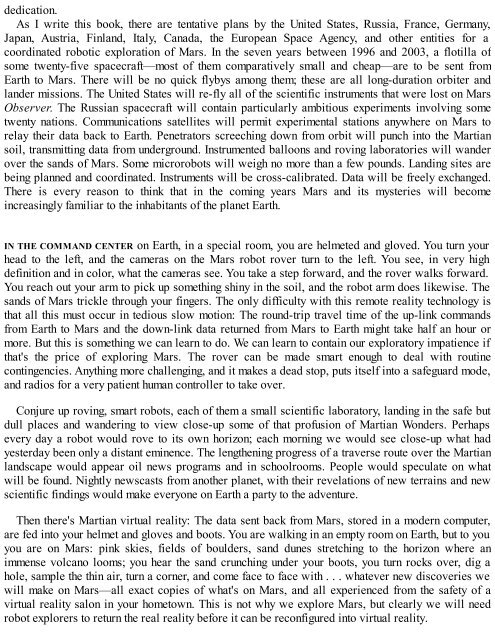Pale Blue Dot ( PDFDrive.com ) (1)
You also want an ePaper? Increase the reach of your titles
YUMPU automatically turns print PDFs into web optimized ePapers that Google loves.
dedication.<br />
As I write this book, there are tentative plans by the United States, Russia, France, Germany,<br />
Japan, Austria, Finland, Italy, Canada, the European Space Agency, and other entities for a<br />
coordinated robotic exploration of Mars. In the seven years between 1996 and 2003, a flotilla of<br />
some twenty-five spacecraft—most of them <strong>com</strong>paratively small and cheap—are to be sent from<br />
Earth to Mars. There will be no quick flybys among them; these are all long-duration orbiter and<br />
lander missions. The United States will re-fly all of the scientific instruments that were lost on Mars<br />
Observer. The Russian spacecraft will contain particularly ambitious experiments involving some<br />
twenty nations. Communications satellites will permit experimental stations anywhere on Mars to<br />
relay their data back to Earth. Penetrators screeching down from orbit will punch into the Martian<br />
soil, transmitting data from underground. Instrumented balloons and roving laboratories will wander<br />
over the sands of Mars. Some microrobots will weigh no more than a few pounds. Landing sites are<br />
being planned and coordinated. Instruments will be cross-calibrated. Data will be freely exchanged.<br />
There is every reason to think that in the <strong>com</strong>ing years Mars and its mysteries will be<strong>com</strong>e<br />
increasingly familiar to the inhabitants of the planet Earth.<br />
IN THE COMMAND CENTER on Earth, in a special room, you are helmeted and gloved. You turn your<br />
head to the left, and the cameras on the Mars robot rover turn to the left. You see, in very high<br />
definition and in color, what the cameras see. You take a step forward, and the rover walks forward.<br />
You reach out your arm to pick up something shiny in the soil, and the robot arm does likewise. The<br />
sands of Mars trickle through your fingers. The only difficulty with this remote reality technology is<br />
that all this must occur in tedious slow motion: The round-trip travel time of the up-link <strong>com</strong>mands<br />
from Earth to Mars and the down-link data returned from Mars to Earth might take half an hour or<br />
more. But this is something we can learn to do. We can learn to contain our exploratory impatience if<br />
that's the price of exploring Mars. The rover can be made smart enough to deal with routine<br />
contingencies. Anything more challenging, and it makes a dead stop, puts itself into a safeguard mode,<br />
and radios for a very patient human controller to take over.<br />
Conjure up roving, smart robots, each of them a small scientific laboratory, landing in the safe but<br />
dull places and wandering to view close-up some of that profusion of Martian Wonders. Perhaps<br />
every day a robot would rove to its own horizon; each morning we would see close-up what had<br />
yesterday been only a distant eminence. The lengthening progress of a traverse route over the Martian<br />
landscape would appear oil news programs and in schoolrooms. People would speculate on what<br />
will be found. Nightly newscasts from another planet, with their revelations of new terrains and new<br />
scientific findings would make everyone on Earth a party to the adventure.<br />
Then there's Martian virtual reality: The data sent back from Mars, stored in a modern <strong>com</strong>puter,<br />
are fed into your helmet and gloves and boots. You are walking in an empty room on Earth, but to you<br />
you are on Mars: pink skies, fields of boulders, sand dunes stretching to the horizon where an<br />
immense volcano looms; you hear the sand crunching under your boots, you turn rocks over, dig a<br />
hole, sample the thin air, turn a corner, and <strong>com</strong>e face to face with . . . whatever new discoveries we<br />
will make on Mars—all exact copies of what's on Mars, and all experienced from the safety of a<br />
virtual reality salon in your hometown. This is not why we explore Mars, but clearly we will need<br />
robot explorers to return the real reality before it can be reconfigured into virtual reality.


